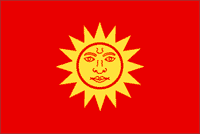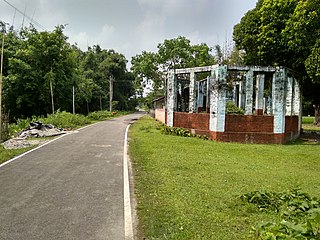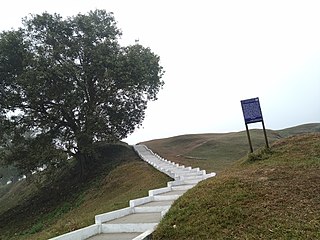
Cooch Behar district is a district of the Indian state of West Bengal.

The Dooars or Duars are the alluvial floodplains in eastern-northeastern India and southern Bhutan that lie south of the outer foothills of the Himalayas and north of the Brahmaputra River basin. This region is about 30 km (19 mi) wide and stretches over about 350 km (220 mi) from the Teesta River in West Bengal to the Dhansiri River in Udalguri district of Assam. The region forms the gateway to Bhutan. It is part of the Terai-Duar savanna and grasslands ecoregion.

Jalpaiguri district is a district of the Indian state of West Bengal. The district was established in 1869 during British Raj.

The Koch dynasty ruled parts of eastern Indian subcontinent in present-day Assam and Bengal. Biswa Singha established power in the erstwhile Kamata Kingdom which had emerged from the decaying Kamarupa Kingdom. The dynasty came to power by removing the Baro-Bhuyans, who had earlier removed the short-lived rule established by Alauddin Hussain Shah.

The Kamata Kingdom emerged in western Kamarupa probably when Sandhya, a ruler of Kamarupanagara, moved his capital west to Kamatapur sometime after 1257 CE. Since it originated in the old seat of the Kamarupa kingdom, and since it covered most of the western parts of it, the kingdom is also sometimes called as Kamarupa-Kamata.

Tufanganj is a town and a municipality of Cooch Behar district in the Indian state of West Bengal. It is the headquarters of the Tufanganj subdivision.
Cooch Behar is the district headquarters and the largest town of Cooch Behar district in the Indian state of West Bengal. The name Cooch Behar is derived from two words—Cooch, a corrupted form of the word Koch, the name of the Koch tribes, and the word behar is derived from vihara meaning land, Koch Behar means land of the Koches.

Cooch Behar Palace is a landmark in Cooch Behar city, West Bengal. It was designed in the Italian Renaissance architecture style and was built in 1887, during the reign of Maharaja Nripendra Narayan of Koch dynasty. It is currently a museum.

The Rabha people are a Tibeto-Burmese ethnic group who live mostly in the Northeast Indian state of Assam, with a lesser population in the adjacent state of West Bengal. They primarily inhabit the plains of Lower Assam and the Dooars, while some are found in the Garo Hills. Most of the Rabhas of Dooars refer to themselves as Rabha, but some of them often declare themselves as Kocha.

The Nashya Shaikh or Nashya Sekh is a Muslim community found in northern parts of the state of West Bengal in India. They are culturally and linguistically similar to both people of northern Bangladesh and Goalpara of Assam. A small number of the community are also found in the neighboring state of Bihar, where they are known as the Bengali Shaikh. The group is descended from a set of tribals which were collectively referred to as Koches, who converted to Islam as they were unable to find a favourable position in Hindu society and came to be known as the Rajbanshi Muslims. They are homogeneous with the Koch people and are bilingual, speaking both Bengali and Surjapuri.

The Koch are a small trans-border ethnic group of Assam and Meghalaya in India and northern Bangladesh. The group consists of nine matrilineal and strictly exogamous clans, with some of them preserving a hitherto sparsely documented Boro-Garo language called Koch, whereas others have switched to local varieties of Indo-Aryan languages. It is a Scheduled Tribe in Meghalaya, India. Koches want to preserve language and culture and heritage.

The Rajbanshi, also Rajbongshi and Koch-Rajbongshi, are peoples from Lower Assam, North Bengal, eastern Bihar, Terai region of eastern Nepal, Rangpur division of North Bangladesh and Bhutan who have in the past sought an association with the Koch dynasty. Koch-Rajbanshi people speak Kamatapuri, belong to Indo-Aryan languages, though in the past they might have spoken Tibeto-Burman languages. The community is categorised as OBC in Assam and Bihar, and SC in West Bengal. In Nepal they are considered part of the Plains Janjati. In Bangladesh the community is classified as Plains ethnic group under 'Barman'. They are the largest Scheduled Caste community of West Bengal.
Gosanimari is both a village and an archaeological site in Dinhata I CD block, in the Dinhata subdivision of the Cooch Behar district of West Bengal, north-eastern India. The name of this site was taken from the modern grampanchyat name of the Dinhata subdivision.

KRNB lects are a cluster of modern lects that are phylogenetic descendants of the proto-Kamata language. The proto-Kamata language began differentiating after 1250 around Kamatapur, the capital city of Kamata kingdom, as the western branch of the proto-Kamarupa, whereas the eastern branch developed into proto-Assamese. Since the 16th century the proto-Kamta community has fragmented giving rise to the differentiated modern lects. The modern lects are: Kamta, Rangpuri (Bangladesh), Rajbanshi (Nepal) and Surjapuri (Bihar).
Goalpara region, largely congruous to the historical undivided Goalpara district, is a region that is associated with the people and culture of Goalpara. It is bounded on the north by Bhutan, on the east by the Kamrup region, in the south by Meghalaya and in the west by Cooch Behar and Jalpaiguri in West Bengal and Rangpur in Bangladesh. The natural landmarks are: Sankosh and Brahmaputra rivers on the west, the Manas river on the east in the north bank, and a corresponding region in the south bank; the Garo Hills in the south and Bhutan Hills in the north.

The Kamtapur Liberation Organisation is a militant organisation based in Northeast India whose objective is to unite the Kamtapur nation from West Bengal and Assam. The proposed state is to comprise all districts in West Bengal and four contiguous districts of Assam which are Cooch Behar, Darjeeling, Jalpaiguri, North and South Dinajpur and Malda, Kokrajhar, Bongaigaon, Dhubri and Goalpara, Kishanganj districts in Bihar, and Jhapa District in Nepal. The KLO was formed to address problems of the Koch Rajbongshi people such as large-scale unemployment, land alienation, perceived neglect of Kamtapuri language, identity, and grievances of economic deprivation.

Nilambar or Nīlambara was the last Khen ruler or Kamadeswar of the Kamata kingdom in Western Assam and North Bengal. He ruled from the city of Kamatapur.

Gohain Kamal Ali was an embanked road that connected the capital of the Koch dynasty, Cooch Behar in North Bengal to heart of Agomani in Dhubri and Narayanpur in Lakhimpur district in Assam, and ran along the foot of the Bhutan hills and the Dafla (Nishi) hills. This was constructed under the supervision of Gohain Kamal, the step-brother of the king, Nara Narayan and was completed in 1547. This was the road that the Koch general Chilarai used soon after for his invasion of the Ahom kingdom, and attacked the Ahom fort at Pichala, which was not a success, but a later movement in 1562 was greatly successful.

Rajpat or Kamtapur Fort is an archaeological site in present-day Gosanimari in the Dinhata I CD block in the Dinhata subdivision of the Cooch Behar district in West Bengal, India.
Sandhya was a king of Kamarupa kingdom in north-eastern India in the present-day state of Assam, India. He founded the Kamata Kingdom when he moved his capital west to Kamatapur sometime after 1257 CE. He became the ruler of Kamarupa in 1228, when Sultan Nasiruddin Mahmud Shah, who had earlier killed his predecessor Raja Prithu in 1228 AD, However, after Nasir-ud-din Mahmud withdrew from Kamrup, Sandhya stopped paying tribute and assumed independence.
















